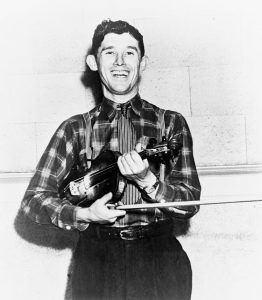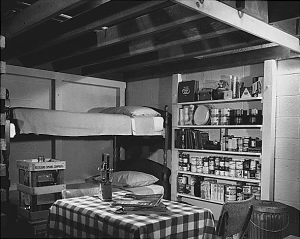by Jochen Markhorst
 A minor faction of Dylanologists argues that “Let Me Die In My Footsteps” is actually the first Dylan song. It is the first composition for which he comes up with the melody all by himself, not borrowing from a Guthrie song or some traditional – hence it being the first real Dylan song.
A minor faction of Dylanologists argues that “Let Me Die In My Footsteps” is actually the first Dylan song. It is the first composition for which he comes up with the melody all by himself, not borrowing from a Guthrie song or some traditional – hence it being the first real Dylan song.
Dylan sees it differently, according to Chronicles:
“I did compose a slightly ironic song called “Let Me Die in My Footsteps.” I based it on an old Roy Acuff ballad.”
Agreed, the simple G-C-D chord scheme can be found. In fact, it can be laid over almost any Roy Acuff song. But then again: that also applies to a million other songs. There is, however, no ballad with a similar melody in Acuff’s oeuvre.
More fascinating is Dylan’s remark at the end of this passage:
“When I began performing “Let Me Die in My Footsteps”, I didn’t even say I wrote it. I just slipped it in somewhere, said it was a Weavers song.”
Remarkable is, obviously, first of all the modesty, the embarrassment even that keeps a young Dylan from saying he has written a song. But moreover: the Weavers reference does not come out of the blue.
Dylan is thinking of an early song by the versatile talent Shel Silverstein (Sheldon Allan Silverstein, 1930-1999), who has a few realistic chances of immortality. His at that time very popular cartoons for Playboy (from 1957 to 1975) do not stand the test of time, nowadays look a bit corny and dull, but on other fronts he has produced timeless hits. Entire generations of Americans grew up and grow up with his children’s books. The best-selling and most translated is The Giving Tree and the disruptive, slightly anarchist Uncle Shelby’s ABZ was and is a masterpiece. His plays are now fading somewhat, as is his poetry. His best songs, however, remain monumental.
First his biggest hit: “A Boy Named Sue”, that the whole world will continue to sing in the version of Johnny Cash. He is also a regular songwriter for Dr. Hook (“Sylvia’s Mother”, “The Cover Of The Rolling Stone”) and Marianne Faithfull probably still is very grateful for the beautiful “The Ballad Of Lucy Jordan”.
He also makes records himself. Less successful, but filled with beautiful songs and sometimes hilarious lyrics. Inside Folk Songs is such an album, and The Weavers pick the song that Dylan thinks of when he announces “Let Me Die In My Footsteps” as a Weavers song: the cabaretesque “Standing On The Outside Of Your Shelter”.
Dylan’s association is obvious. Just like Footsteps, Silverstein’s song is inspired by the half-hysterical phenomenon of thousands of Americans digging fallout shelters in the backyard for fear of the nuclear Apocalypse. “Standing Outside Your Shelter” transforms that sad phenomenon humorously to a funny song:
I’m standing on the outside of your shelter, lookin’ in,
While the bombs are here a-droppin’ everywhere.
Through the glass, you look so sweet and warm,
And safe and cosy — Have I ever told you that I care?
Humour cannot be found in Dylan’s song, although he himself values it as “slightly ironic” in Chronicles. The lyrics are in fact stately, patriotic, infused with Woody Guthrie, sometimes poetic, here and there somewhat naive-pacifist (the I’d buy the whole world couplet, for example) and some one-liners have an uncomfortably high level of greeting cards wisdom. “One must learn to live, not learn to die”, and all that – whereby the young poet will, by the way, offend seasoned philosophers from Plato, Seneca and Cato to Thomas à Kempis and Erasmus; they all can explain very well that, quite on the contrary, learning to die is a higher purpose of human life.
https://youtu.be/13KcdxpRn4Y
Despite those few less shiny moments, the song is and will most certainly remain one of the early masterpieces from the bard’s repertoire. Beautiful melody, hypnotic cadence and a catchy recurring verse line as a chorus. Dylan is pleased too, initially. In March ’62 he proudly presents Footsteps to his mentor Izzy Young, it has been on the track list for The Freewheelin‘ for some time, the recording, 25 April 1962, is one-take only and columnist Nat Hentoff from The Village Voice has already written the song’s background information for the liner notes. Folk magazine Broadside is allowed to publish the lyrics (April ’62, with a different title by the way: “I Will Not Go Down Under The Ground”) and in July it is on his set list.
A few months later, though, he seems to be fed up already. He breaks off a Witmark recording halfway and a moment later “Let Me Die In My Footsteps” has also been removed from the track list for The Freewheelin’ – it is being replaced by “Masters Of War”.
It is one of the first times, but certainly not the last time that Dylan rejects a beautiful song for a recording, heartlessly degrading it to a throw-away. Usually for reasons of his own, baffling, even reproachable in the eyes of us mere mortals. “Mama, You Been On My Mind”, for example, and “I’ll Keep It With Mine”, “Blind Willie McTell”, “Series Of Dreams” and dozens more, which we eventually can enjoy after all, thanks to illegal bootlegs and later the Bootleg Series.
But in this case it is at least somewhat understandable. The young poet / singer has written songs like “Blowin ‘In The Wind” and “A Hard Rain’s A-Gonna Fall” and recognizes the difference in quality: these songs are universal, vague, poetic and ambiguous enough to provide a timeless, transcendent value.
 “Let Me Die In My Footsteps”, on the other hand, is topical, hung up on a passing, time-bound craze. In 1959, fallout shelters become commonplace to the extent that women’s magazines publish photo reports with interior tips. In the September ’61 issue of Life Magazine, President Kennedy writes an open letter to all Americans advising them to build fallout shelters, and a little later DIY-kits are for sale at the hardware store. After the Cuban Missile Crisis, October ’62, however, the hysteria gradually starts to fade away and this does not escape Dylan – his song vaguely smells of a slogan song anyway, but now it also starts to sound old-fashioned. “I’ve sung it too many times,” he says as he discards the song – which doesn’t sound too credible from the man who will sing a “Blowin ‘In The Wind” more than a thousand times, a “Like A Rolling Stone” more than two thousand times.
“Let Me Die In My Footsteps”, on the other hand, is topical, hung up on a passing, time-bound craze. In 1959, fallout shelters become commonplace to the extent that women’s magazines publish photo reports with interior tips. In the September ’61 issue of Life Magazine, President Kennedy writes an open letter to all Americans advising them to build fallout shelters, and a little later DIY-kits are for sale at the hardware store. After the Cuban Missile Crisis, October ’62, however, the hysteria gradually starts to fade away and this does not escape Dylan – his song vaguely smells of a slogan song anyway, but now it also starts to sound old-fashioned. “I’ve sung it too many times,” he says as he discards the song – which doesn’t sound too credible from the man who will sing a “Blowin ‘In The Wind” more than a thousand times, a “Like A Rolling Stone” more than two thousand times.
The spiritual father may reject his song, but it does – of course – survive. On Broadside Ballads Vol. 1, the first folk compilation album from the eponymous folk magazine, released in 1963, is a first official, pretty nice recording, performed by Happy Traum – with friend Dylan in the background.
After that it remains silent for a while, until in ’72 the cheerful quartet of born musicians Coulson, Dean, McGuinnes and Flint, led by producer Manfred Mann, present an eccentric, beautiful cover. Hippie spirits still float around, the Tibetan Book of the Dead is on many a coffee table and the British opt for a George Harrison / Ravi Shankar approach with Indian tabla’s and mantra-like unison singing. That works wonderfully well; surprisingly, the song gains depth, it acquires a (quasi-) Eastern-philosophical added value. Brilliant, but it doesn’t make waves, unfortunately.
Only the release of the original, on The Bootleg Series 1-3 (1991), really leads to a second life. The country version of Alastair Moock (on Bad Moock Rising, ’99) has the empty-headed beauty of a dumb blonde, but it is nevertheless quite beautifully made. Jason Bennet from Colorado Springs often produces successful Dylan covers (“Abandoned Love”, “Shooting Star”) and his Footsteps may be somewhat conservative, but is touching still (on the collection Positively Pikes Peak – The Pikes Peak Region Sings Bob Dylan, 2011 ).
The most beautiful cover is anything but conservative. For a stage adaptation of Orwell’s 1984 (2015), one Liz Mistele with David Kaye and the otherwise little famous band Electric Mustache sing a gothic, dramatic version of “Let Me Die In My Footsteps”. The arrangement winks at Dylan’s “Love Sick”, the sound goes back to the industrial New Wave from say 1984, a second guitar imitates symphonic rock doodling from the 70s and the singer maintains an attractive tension between dedain and pathos – and thus this version of a song Dylan wrote back in 1961 bridges half a century of popular music.
What else is here?
An index to our latest posts arranged by themes and subjects on the home page. You can also see details of our main sections on this site at the top of this page under the picture.
There is an alphabetic index to the 550+ Dylan compositions reviewed on the site which you will find it here. There are also 500+ other articles on different issues relating to Dylan. The other subject areas are also shown at the top under the picture.
We also have a discussion group “Untold Dylan” on Facebook which mostly relates to Bob Dylan today. Just type the phrase “Untold Dylan” in, on your Facebook page or follow this link
And please do note The Bob Dylan Project, which lists every Dylan song in alphabetical order, and has links to licensed recordings and performances by Dylan and by other artists, is starting to link back to our reviews.

We are actively promoting a link to this interesting topic on The Bob Dylan Project at:
http://thebobdylanproject.com/Song/id/354/Let-Me-Die-in-My-Footsteps
If you are interested, we are a portal to all the great information related to this topic.
Join us inside Bob Dylan Music Box.